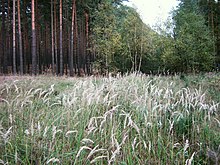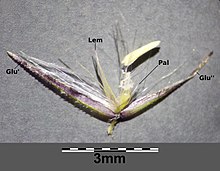Country riding grass
| Country riding grass | ||||||||||||
|---|---|---|---|---|---|---|---|---|---|---|---|---|

Land riding grass ( Calamagrostis epigejos ) |
||||||||||||
| Systematics | ||||||||||||
|
||||||||||||
| Scientific name | ||||||||||||
| Calamagrostis epigejos | ||||||||||||
| ( L. ) Roth |
The small-reed ( Calamagrostis epigejos (L.) Roth ), also called sand-reed grass , sand tube , country tube , country reeds or wood reeds called, is a plant of the genus of the Calamagrostis ( Calamagrostis ) in the family of the sweet grasses (Poaceae).
description

The land riding grass is a perennial, herbaceous plant that reaches heights of between 80 and 150 cm. It forms long, subterranean runners . The strong stalks are rough in the upper half. The blue to gray-green leaf blades are up to 70 cm long and 2 cm wide and are very rough on top with a sharp edge. The up to 9 mm long ligules are strong.
The flowering period extends from July to August. Later in the year, after the actual flowering period, the inflorescences are still clearly visible. The paniculate inflorescences are narrow and stand upright. The thick panicle branches are up to 10 cm long, upright and also rough. The spikelets are between 5 and 7 mm long and are single-flowered. The glumes are linear and awn-like pointed. The provided with a fringe of hair lemmas are three annoying. The awn above the middle of the lemma is dorsal and rises above it by more than a third.
The number of chromosomes is 2n = 28, 42 or 56.
ecology
It is moderately demanding and survives the winter as a partly evergreen geophyte and hemicryptophyte . As a pioneer of root creeping, it can form herds that inhibit forest regeneration in clear cuts . The vegetative reproduction takes place very numerous through the very long, thin, underground rhizomes. The land riding grass is a rhizome - geophyte , which roots up to 2 m deep. The roots are very rich in starch; the starch grains are composed.
In terms of flower biology, it is of the "long-dust thread type". The pollination is carried by the wind.
There are so-called "spelled fruits". The spreading unit ( diaspores ) are the caryopses covered by the husks , which spread out as umbrella fliers, water and Velcro fasteners. The fruit ripens from August to October.
Occurrence
The land riding grass occurs in the temperate zones of Eurasia and Africa. It occurs all over Germany from the lowlands to medium mountain ranges (in Austria mostly at altitudes of up to 1140 meters). In the Allgäu Alps in Vorarlberg at the Schröcken church it rises up to 1,270 meters above sea level.
It can be found in dry to moderately fresh, often water-rich or water-retaining, humus or raw, mostly deep, preferably sandy-gravelly loamy soils. The species is particularly common in sparse deciduous and coniferous forests, on fields, on paths and field edges, on coastal and inland dunes and on damp river banks. In the east of North America the species occurs as a neophyte . It thrives optimally in societies of the Atropetalia order, but also occurs in societies of the Molinion, Salicion albae or the Artemisietea or Agropyretea classes.
The common beach grass ( Ammophila arenaria (L.) Link ) forms a genus bastard by crossing with the land riding grass , the Baltic beach grass ( Calammophila baltica (Flüggé ex Schrad.) Brand , syn .: Ammocalamagrostis baltica (Flüggé ex Schrad.) P . Fourn. ).
Common names
For the land riding grass, there are or existed, partly only regionally, the other German-language trivial names : Hügelrohr, Reid and Siegrühr ( Siebenbürgen in the Rauthal ).
use
The land riding grass can be used as scatter grass and for dune planting.
literature
- Erich Oberdorfer : Plant-sociological excursion flora. Ulmer, Stuttgart 1994, ISBN 3-8252-1828-7
- Ruprecht Düll , Herfried Kutzelnigg : Pocket dictionary of plants in Germany and neighboring countries. The most common Central European species in portrait . 7th, corrected and enlarged edition. Quelle & Meyer, Wiebelsheim 2011, ISBN 978-3-494-01424-1 . (Section ecology)
Individual evidence
- ↑ a b c Erich Oberdorfer : Plant-sociological excursion flora for Germany and neighboring areas . 8th edition. Verlag Eugen Ulmer, Stuttgart 2001, ISBN 3-8001-3131-5 . Page 254.
- ↑ Rafaël Govaerts (ed.): Calamagrostis epigejos. In: World Checklist of Selected Plant Families (WCSP) - The Board of Trustees of the Royal Botanic Gardens, Kew . Retrieved November 3, 2016.
- ↑ Erhard Dörr, Wolfgang Lippert : Flora of the Allgäu and its surroundings. Volume 1, IHW, Eching 2001, ISBN 3-930167-50-6 , p. 162.
- ^ Georg August Pritzel , Carl Jessen : The German folk names of plants. New contribution to the German linguistic treasure. Philipp Cohen, Hannover 1882, page 71, online.
Web links
- Country riding grass. In: FloraWeb.de.
- Country riding grass . In: BiolFlor, the database of biological-ecological characteristics of the flora of Germany.
- Profile and distribution map for Bavaria . In: Botanical Information Hub of Bavaria .
- Calamagrostis epigejos (L.) Roth In: Info Flora , the national data and information center for Swiss flora . Retrieved September 30, 2015.
- Distribution in the northern hemisphere according to Hultén
- Thomas Meyer: Data sheet with identification key and photos at Flora-de: Flora von Deutschland (old name of the website: Flowers in Swabia )
- photos


